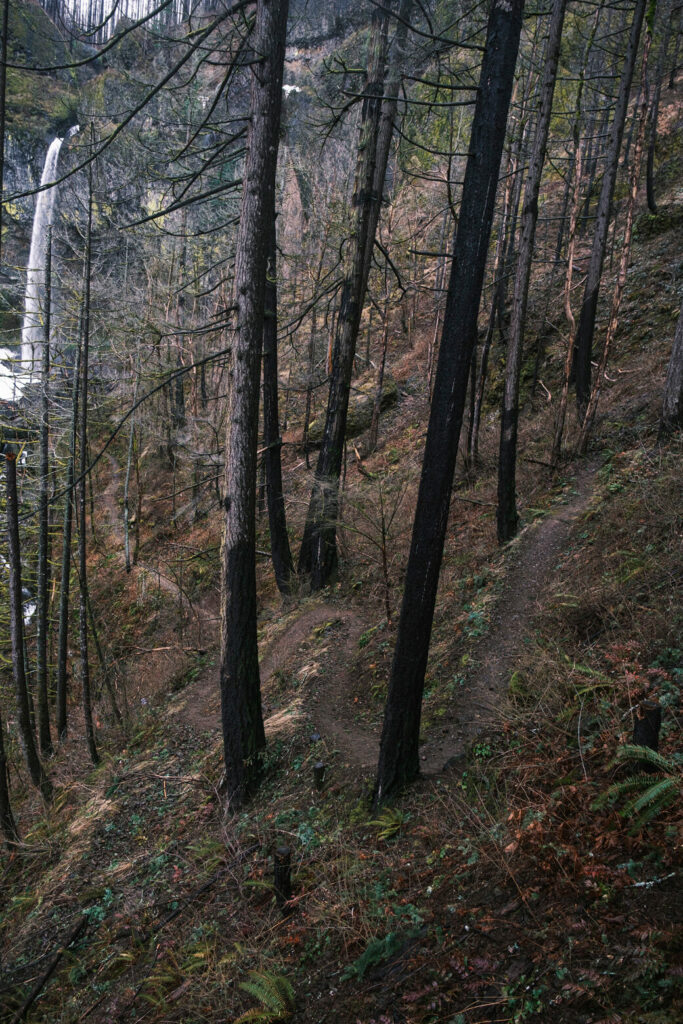A Trail Runner’s Guide to Wildfire
Over the past few weeks, I’ve lost track of how many times I’ve laced up my running shoes, stretched out my legs, and bolted out the front door, only to find my entire neighborhood engulfed in a haze of wildfire smoke. As wildfires continue to rage across much of the Pacific Northwest, dangerous levels of smoke have consumed many of my usual routes in Central Oregon, making running hazardous to human health.
Unfortunately, I’m not the only one encountering these issues this summer. Individuals and communities are dealing with increasing concerns as larger and more frequent wildfires continue to burn worldwide. In the past few months, devastating fires have raged through the Hawaiian town of Lahaina, burned millions of acres in Canada, and caused mass evacuations in large parts of Southern Europe.
As trail runners, we’re accustomed to dealing with the elements, but the effects of wildfire season have proven to be a more persistent and dangerous roadblock to our running habits. Every year, we find ourselves trapped indoors as smoke descends on our communities, canceling races and forcing us to find new ways to practice our passion in this rapidly changing climate.
Is Wildfire Smoke Really That Bad?
“I think everyone should have a healthy level of concern for wildfire smoke,” says Dr. Stephanie Cleland, an Assistant Professor and environmental health expert at Simon Fraser University in Vancouver, Canada.
This healthy level of concern is especially true for runners. When exercising, your ventilation rate and depth of breathing increases, causing you to inhale more polluted air, which can increase the chances of harming your physical health and safety, explains Dr. Cleland. In recent years, researchers have linked prolonged exposure to wildfire smoke with detrimental health effects, including lower levels of cognitive performance and the risk of lung disease.
“Even if you’re a healthy person, at a certain level, it’s really going to start affecting you as well,” says Dr. Cleland. “So, I think it’s really important for everyone to familiarize themselves with how to check their air quality and air quality health.”
The Air Quality Index (AQI) is a scale the Environmental Protection Agency (EPA) uses to report air quality levels in the United States. The AQI scale runs from 0 to 500, with a higher number meaning the poorer the air quality and the greater the health concern. At levels above 100, members of sensitive groups (children, elderly, and individuals with health risks) may start to experience health effects, and above 150, there is a concern for some members of the general public. Once air quality levels venture north of 200, the risk of health effects increases for everyone.
These levels are measured based on five major pollutants: particle pollutants, ground-level ozone, carbon monoxide, sulfur dioxide, and nitrogen dioxide. Particle pollutants, known as PM 2.5, are the most common health indicators during wildfire smoke events.
“The reason PM 2.5 is one of the health indicators when they look at wildfire smoke is that it can get into the deepest part of your lungs and enter your bloodstream,” explains Dr. Cleland. “It can kind of cause this whole cascade of different adverse health outcomes.” Recent research has linked exposure to PM 2.5 with respiratory and cardiovascular hospitalizations, decreased cognitive functioning, and reduced birth weights.
During our interview, Dr. Cleland was calling in from Vancouver, Canada, where smoke was masking the skies of the coastal metropolis. The smoke is a byproduct of over 5,000 fires that have burned over 35 million acres of land throughout Canada. In Kelowna, Canada, a couple hundred miles from Vancouver, local wildfires have been causing hazardous levels of PM 2.5 for weeks.
“10 micrograms per meter cubed is a pretty average daily level of PM 2.5,” says Dr. Cleland. “And then if you look at Kelowna (Canada), for example, it’s exceeding 300 plus micrograms per meter cubed.” Exercising outdoors is not an option at these levels, and the EPA currently indicates any levels of PM 2.5 above 12 micrograms per meter cubed is unhealthy.
In Kelowna, running is also the least of the local community’s concerns. Many have lost homes, businesses, and livelihoods to the devastating wildfires, providing a stark reminder that there are much more catastrophic consequences to wildfires and climate change.

Can You Race During Fire Season?
Todd and Renee Janssen have been organizing races for the last decade through Go Beyond Racing, which they founded in 2013. The company organizes races across Oregon and Washington, with 14 events scheduled throughout the year, including the Stumptown Trail Runs in Portland, the Wy’east Wonder 50-mile & 50-kilometer on Mt. Hood, and the recently debuted Oregon 200-Miler in Oakridge.
Organizing, planning, and executing that many races in a year takes a tremendous amount of time and work, and although Todd and Renee have plenty of volunteers to support their events, they still spend countless hours preparing for each race. This includes scheduling, gathering permits, planning routes, setting up aid stations, and directing the race. During these planning phases, they are now having to consider new risks and precautions because of the growing prominence of wildfires.
“Wildfire really wasn’t part of the equation even five years ago,” says Todd Janssen. “But it’s becoming more and more a part of the planning portion of these races.”
For each race, they have to take a deeper look at their routes and how they may be influenced by wildfire, including locations of potential staging areas for firefighter crews, monitoring smoke levels throughout the course, and ensuring the ability to access safety routes in the case of an emergency.
“There are a lot of things that race directors will have to do differently going forward with wildfire becoming more of a reality,” says Janssen. “It’s just become so much a part of our little world that it’s definitely a part of the equation now.”
Although wildfires have become more frequent over the years, racers and organizers have felt the consequences of fire for the past few decades.
In 2008, the Western States Endurance Run 100-mile (WSER), one of the most celebrated races in the world, was canceled due to an unprecedented fire season in California. The cancellation is one of only two times the iconic race has been canceled; the other was in 2020 due to the COVID-19 pandemic. In September and October of 2022, about 16 miles of the Western States Trail, between Last Chance and a point 6 miles west of Foresthill on the California Street section of the trail, was closed due to the Mosquito Wildfire that burned more than 76,000 acres. Race organizers, the USFS, and California State Parks worked in partnership through the winter and spring to eliminate hazards caused by the fire, and repair the trailwhere a record level of precipitation (rain and snow) caused further damage to the trail due to the lack of vegetation in severely burned areas and resultant erosion. A combination of over $100,000 in Federal Burned Area Emergency Response funds, labor provided by Federal and State partners, over 6,000 volunteer hours, and over $200,000 in funds used to pay for additional USFS resources and contractors, allowed sufficient work to be completed by May 1, 2023 such that the full length of the trail was open to the public well in advance of the ultra-marathon in late June.
Other races have also dealt with the consequences of wildfire season. In 2002, nearby wildfires canceled the Hardrock 100 in Southwest Colorado. The race was nearly canceled by wildfires again in 2018. In eastern Washington, the Plain 100 ultra-marathon has been abandoned three times due to wildfire and smoke. More recently, the 2023 Ironman Canada-Penticton triathlon in British Columbia was canceled due to this summer’s Canadian wildfires.
“The unpredictability of the fires means the province needs to have maximum flexibility to ensure the proper supports are available to those who need them. We have seen conditions change dramatically – almost hour by hour – and all resources need to be directed towards keeping our communities safe,” said Mayor of Penticton Julius Bloomfield in a statement issued by the Ironman organizers.
This unpredictability ultimately makes it harder on racers, too. Nowadays, most races open registration six months in advance, and race day conditions are nearly impossible to predict ahead of time. The chances of poor air quality or wildfire can deter individuals from committing to a race because a canceled event can result in the loss of fees, travel costs, and time.
That’s why it’s important to consider these possibilities when signing up for a race during the fire season, explains Janssen. Make sure to check the refund policies, be aware of the risks that could impact the race, and understand that no one wants the race to be canceled. The potential of wildfire is just the reality of our current situation and the price we pay for getting to race in some of the most beautiful locations on Earth.
When Can You Run?
Unfortunately, there’s really no right answer to this question, and the lack of control during wildfire season can be frustrating. Whether it’s okay to run and the severity of risks associated with wildfire smoke is entirely dependent on your health and situation. That’s why the best thing we can do is learn to adapt and put ourselves in a position to make informed decisions about when it’s okay to run outdoors.
One of the best ways to stay informed is to check indexes such as PurpleAir or AirNow, which provide air quality levels and help determine the risk of recreating outdoors. In addition, we can adjust our training schedule, using the real-time maps available to us to find better air and timing trends for when air quality is predicted to improve. If you have to get in that daily run or training session, consider moving your session inside to a space with a filter, or try to minimize your exposure to the smoke by wearing an N-95 mask and keeping the duration shorter and intensity lower.
These options are primarily helpful when air quality levels are still within those questionable ranges that may only affect certain groups or members of the public. When air quality levels worsen and pose a risk to everyone, it’s better to pack it up and stay inside. On those days, it’s best to find ways to recreate indoors and make the most of the circumstances. “We can’t directly control when it’s going to be smoky or when it’s not,” says Dr. Cleland. “We can control how we react and protect ourselves.”
